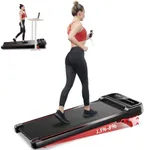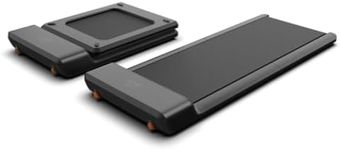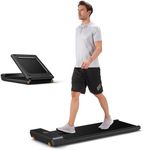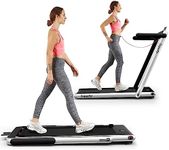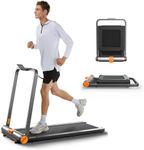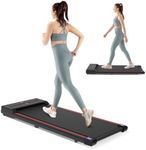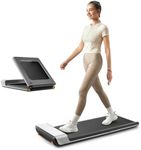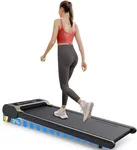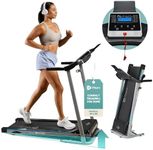Buying Guide for the Best Under Desk Treadmill
Choosing an under-desk treadmill is a great way to stay active while working or studying. The right model can help you maintain your health, boost your energy, and make your workday more dynamic. When picking an under-desk treadmill, it's important to consider how much space you have, how you plan to use it, and what features will make it comfortable and convenient for your daily routine. Understanding the key specifications will help you find a treadmill that fits your needs and lifestyle.Motor PowerMotor power, usually measured in horsepower (HP), determines how smoothly and quietly the treadmill runs. A higher motor power means the treadmill can handle more weight and longer use without overheating. For light walking while working, a lower motor (around 1.5 HP) is usually enough, while heavier users or those planning to walk for several hours a day may benefit from a stronger motor (2.0 HP or more). If you plan to use the treadmill for short, occasional walks, a lower power is fine, but for daily, extended use, look for a higher-powered motor.
Speed RangeThe speed range tells you how fast the treadmill can go, usually measured in miles per hour (mph) or kilometers per hour (km/h). Under-desk treadmills typically have a lower top speed than regular treadmills, focusing on walking rather than running. If you want a gentle stroll while working, a top speed of 2-3 mph is enough. If you want the option to walk briskly or use the treadmill for light jogging during breaks, look for models that go up to 4-5 mph. Think about your comfort and how fast you like to walk while multitasking.
Deck SizeDeck size refers to the length and width of the walking surface. A longer and wider deck gives you more room to walk comfortably and safely, especially if you have a longer stride. Compact decks (under 40 inches long) save space but may feel cramped for taller users, while longer decks (over 45 inches) offer more comfort but take up more room. Choose a deck size that matches your height and walking style, and make sure it fits under your desk and in your workspace.
Weight CapacityWeight capacity is the maximum user weight the treadmill can safely support. It's important for safety and durability. Lighter models may support up to 220 pounds, while sturdier ones can handle 250 pounds or more. Always pick a treadmill with a weight limit higher than your own weight to ensure long-term reliability and smooth operation.
Noise LevelNoise level describes how loud the treadmill is when in use. Quieter treadmills are better for shared or open workspaces, as they won't disturb others or interfere with phone calls. Noise is affected by the motor, belt, and overall build quality. If you work in a quiet environment or take a lot of calls, look for models that advertise low noise or have user reviews mentioning quiet operation.
Portability and StoragePortability and storage features include the treadmill's weight, whether it has wheels, and how easy it is to move or store when not in use. Lighter, foldable models are easier to slide under a desk or bed, while heavier ones may be more stable but harder to move. If you need to clear space often or share your workspace, prioritize a treadmill that's easy to move and store.
Display and ControlsThe display and controls let you track your speed, time, distance, and sometimes calories burned. Some under-desk treadmills have simple remote controls, while others have built-in displays on the deck. If you like to monitor your progress or adjust settings easily, look for clear, accessible controls. Consider how you'll use the treadmill—if it's under a desk, a remote or app control may be more convenient than a built-in display.
